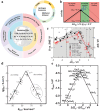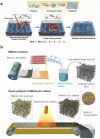Drivers and Pathways for the Recovery of Critical Metals from Waste-Printed Circuit Boards
- PMID: 38837685
- PMCID: PMC11321694
- DOI: 10.1002/advs.202309635
Drivers and Pathways for the Recovery of Critical Metals from Waste-Printed Circuit Boards
Abstract
The ever-increasing importance of critical metals (CMs) in modern society underscores their resource security and circularity. Waste-printed circuit boards (WPCBs) are particularly attractive reservoirs of CMs due to their gamut CM embedding and ubiquitous presence. However, the recovery of most CMs is out of reach from current metal-centric recycling industries, resulting in a flood loss of refined CMs. Here, 41 types of such spent CMs are identified. To deliver a higher level of CM sustainability, this work provides an insightful overview of paradigm-shifting pathways for CM recovery from WPCBs that have been developed in recent years. As a crucial starting entropy-decreasing step, various strategies of metal enrichment are compared, and the deployment of artificial intelligence (AI) and hyperspectral sensing is highlighted. Then, tailored metal recycling schemes are presented for the platinum group, rare earth, and refractory metals, with emphasis on greener metallurgical methods contributing to transforming CMs into marketable products. In addition, due to the vital nexus of CMs between the environment and energy sectors, the upcycling of CMs into electro-/photo-chemical catalysts for green fuel synthesis is proposed to extend the recycling chain. Finally, the challenges and outlook on this all-round upgrading of WPCB recycling are outlined.
Keywords: artificial intelligence; catalysts; critical metals; green metallurgy; hyperspectral sensing; waste printed circuit board.
© 2024 The Author(s). Advanced Science published by Wiley‐VCH GmbH.
Conflict of interest statement
The authors declare no conflict of interest.
Figures











Similar articles
-
Mechanism of PGMs capture from spent automobile catalyst by copper from waste printed circuit boards with simultaneous pollutants transformation.Waste Manag. 2024 Sep 15;186:130-140. doi: 10.1016/j.wasman.2024.06.001. Epub 2024 Jun 14. Waste Manag. 2024. PMID: 38878477
-
Catalytic pyrolysis of waste printed circuit boards to organic bromine: reaction mechanism and comprehensive recovery.Environ Sci Pollut Res Int. 2023 Oct;30(49):108288-108300. doi: 10.1007/s11356-023-29944-1. Epub 2023 Sep 25. Environ Sci Pollut Res Int. 2023. PMID: 37743446
-
Waste-Printed Circuit Board Recycling: Focusing on Preparing Polymer Composites and Geopolymers.ACS Omega. 2020 Jul 16;5(29):17850-17856. doi: 10.1021/acsomega.0c01884. eCollection 2020 Jul 28. ACS Omega. 2020. PMID: 32743155 Free PMC article. Review.
-
Recovery of precious metals from waste printed circuit boards though bioleaching route: A review of the recent progress and perspective.J Environ Manage. 2023 Dec 15;348:119354. doi: 10.1016/j.jenvman.2023.119354. Epub 2023 Oct 19. J Environ Manage. 2023. PMID: 37864939 Review.
-
Bioleaching of Typical Electronic Waste-Printed Circuit Boards (WPCBs): A Short Review.Int J Environ Res Public Health. 2022 Jun 19;19(12):7508. doi: 10.3390/ijerph19127508. Int J Environ Res Public Health. 2022. PMID: 35742757 Free PMC article. Review.
References
-
- a) Cheisson T., Schelter E. J., Science 2019, 363, 489; - PubMed
- b) Graedel T., Reck B. K., Miatto A., Nat. Commun. 2022, 13, 150; - PMC - PubMed
- c) Sovacool B. K., Ali S. H., Bazilian M., Radley B., Nemery B., Okatz J., Mulvaney D., Science 2020, 367, 30; - PubMed
- d) Raabe D., Chem. Rev. 2023, 123, 2436. - PMC - PubMed
-
- a) Wang A., Yuan X., Bulletin of Chinese Academy of Sciences 2022, 37, 1550;
- b) Vivoda V., Matthews R., McGregor N., Resources Pol 2024, 89, 104587;
- c) Işıldar A., Huisingh D., CRC Press 2024.
-
- a) Zeng X., Mathews J. A., Li J., Environ. Sci. Technol. 2018, 52, 4835; - PubMed
- b) Xavier L. H., Ottoni M., Abreu L. P. P., Resour. Conserv. Recy. 2023, 190, 106840.
-
- a) Awasthi A. K., Li J., Koh L., Ogunseitan O. A., Nat. Electron. 2019, 2, 86;
- b) Sasso L., in Taylor & Francis Group, CRC Press, Oxfordshire, UK: 2023, Ch. 2.
-
- Baldé C. P., Kuehr R., Yamamoto T., McDonald R., D'Angelo E., Althaf S., Bel G., Deubzer O., Fernandez‐Cubillo E., Forti V., Gray V., Herat S., Honda S., Iattoni G., Khetriwal D. S., Cortemiglia V. L. d., Lobuntsova Y., Nnorom I., Pralat N., Wagner M., Electronic Waste Rising Five Times Faster than Documented E‐waste Recycling: UN, https://ewastemonitor.info/the‐global‐e‐waste‐monitor‐2024/ (accessed: February 2024).
Publication types
Grants and funding
LinkOut - more resources
Full Text Sources
Research Materials
